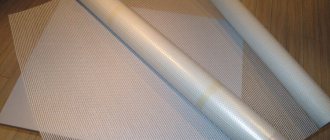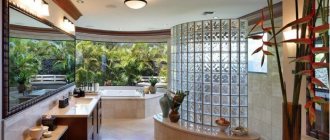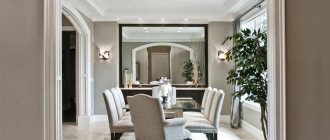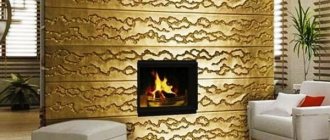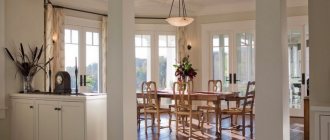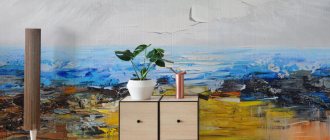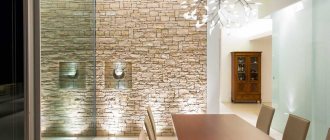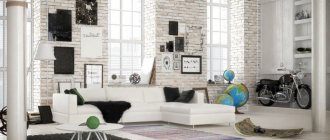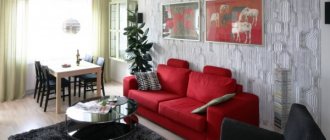The role of ceiling plinth in design
Thanks to the plinth, the ceiling can look dazzling, acquiring a unique, elegant character in a new atmosphere. Among the ceiling decorations you will find a wide range of inspiration: cornices, strips, rosettes, domes, as well as baseboards, which with a little creativity can change the feel of an entire room. Many solutions, the ability to combine ceiling decorations with each other, as well as simple assemblies, open new doors for interior decorators. Ceiling skirting boards are an easy way to cover the gap between walls and ceiling with a tasteful and subtle accent. The richness of the design represents both classic and more modern styles, allowing you to satisfy the most sophisticated tastes and expectations.
Scope of application of ceiling skirting boards
The fillets for decorating the ceiling surface are different:
- material of manufacture;
- scope of application.
Regardless of what kind of skirting boards there are for the ceiling, they must be chosen so that the option that is preferred fits well into the interior of the room:
- Products made of polyvinyl chloride. They harmonize best with finishes made of plastic panels. Many varieties of such fillets are equipped with a special groove that allows for their quick installation. PVC elements will be an excellent solution when installing suspended ceiling structures.
- Their foam products. It is usually used when finishing surfaces made of plasterboard. It is also well suited for ceilings and walls that have been finished with putty or plaster. In this case, not an adhesive composition, but a putty solution is used for fastening.
- Polystyrene foam fillets. They are a good solution for decorating surfaces made of gypsum or plastic materials. To fix them, use either glue or putty.
- Products made of polyurethane. These universal elements are suitable for coatings made of different materials. If there are a large number of curved sections, their use is often the only possible choice.
- Plaster plinths. Best suited for creating classical compositions. Often they are mounted only in corners. For installation use putty.
- Wooden plinths. Rarely found in modern interiors. They go well with natural wood surfaces.
Baguette installation technology
- The baguette should be glued along the intended line. Distribute excess glue along the entire length of the baseboard. Then carefully remove the unnecessary amount of glue with a sponge or damp cloth.
- Use a pencil to mark the desired length of the ceiling plinth, remove excess, and coat the rest with glue. Don’t forget to coat the joints of the baguette. Fill small gaps in the joints with putty and then sand the seams;
- To extend the service life of the ceiling plinth, paint is applied to its surface in several layers.
Excess glue and putty is removed
To resolve the contradiction that has arisen (a ceiling plinth is needed, but the base cannot withstand the load), let’s try to reformat the question: let’s think not about how to properly glue baguettes to the ceiling, but about how to install a decorative panel at the junction of the ceiling and wall.
The easiest way is to use lightweight foam plastic models that are glued to the wallpaper without preliminary surface preparation:
- Before gluing the ceiling moldings, we apply markings to the wall. At the same time, we mark the line along which the lower edge of the fillet will be placed, making sure that the upper edge does not pierce the canvas.
The lightweight detail also adheres well to wallpaper
- After marking, we take the parts and cut them to size. To make adjustments in the corners, we use a miter box - a device for sawing panels at clearly defined angles. You can work with either a sharp knife or a special file for polystyrene.
- Having cut all the parts to size, apply a small amount of adhesive mixture to the bottom of the first panel. When choosing how to glue baguettes to the ceiling, we give preference to special compounds for polystyrene foam or polyurethane, since they will ensure the best adhesion.
For work it is better to use a special composition
- We apply the baguette to the wallpaper, carefully align it and immediately remove any drops of glue protruding from under the bottom edge.
- Press the part until it locks into place. After that, install the remaining panels in the same way.
If, instead of light foam or polystyrene molding, you take a fairly heavy embossed baguette, then there is a risk that, under the weight of this part, the wallpaper will begin to peel off over time. In this case, we need to ensure contact of the finish with the wall.
Trimming parts using a miter box
- First, we cut all the parts to size, forming the corner joints using a miter box.
- Place the panel against the wall, marking where its bottom edge will be.
- Using a long metal ruler, level or rule, we draw a line along which we will need to cut the wallpaper. It is better to leave a margin of 0.5 - 1 mm, since it is much easier to cut off a thin strip of material when gluing it than to then mask the gap through which the plaster will be visible.
- Using a sharp knife, cut through the entire thickness of the wallpaper.
- Using a spatula, carefully remove the wallpaper from the wall. If necessary, they can be moistened.
Carefully glue the part without touching the canvas
- Before sticking the baguette on the ceiling, clean the wall under the wallpaper and then apply a penetrating primer to it. We carefully ensure that the soil does not fall on the tension fabric, and if this happens, quickly remove the drops with a damp cloth.
- Next, we carry out the work in the same sequence as in the previous case.
As for wood products, here we will have to decide not what to glue the baguettes to on the ceiling, but how to fix them on the walls so that a fairly heavy part is securely fixed.
The instructions suggest the following installation sequence:
- . We cut the corners at 45, forming neat joints with minimal gaps.
Installation of mounting blocks
- The bevel of the edge of such a part must correspond to the configuration of the baguette.
- . Using the markings, we drill holes that we use to fasten the wooden corners with dowels.
Fixing the decorative panel
- . We carefully sand the baseboard, trying to ensure that as little wood dust gets on the tension fabric as possible.
Types of ceiling skirting boards
Nowadays, baguettes with the following qualities are popular:
- aesthetics;
- beautiful decor;
- practicality;
- functionality.
Manufacturers try to satisfy customer requests and produce a wide range of curtain rods for every taste, for various purposes and in different price categories. In specialized stores you can find ceiling plinths of various configurations, styles, materials, colors and decorative solutions.
To make the right choice, you must first decide for what purpose the cornice is needed:
- to give the finish a finished look;
- as an important element that complements the interior style that will decorate the room;
- as a channel for electrical wiring;
- to hide gaps between walls and suspended ceilings;
- to install LED strip lighting;
- as string decorative cornices for curtains over windows;
- to hide imperfections after local repairs at the junctions of walls and ceilings or an unattractive corner.
According to the assigned tasks, one or another option is selected.
The material used to make the fillets is also important. In modern construction, a mandatory requirement for ceiling plinths is light weight. This reduces the load on the fastening and also eliminates the possibility of injury to people if the baguette falls.
Modern moldings are made from several materials:
- polystyrene foam;
- polyvinyl chloride;
- polystyrene;
- polyurethane;
- wood;
- gypsum
The last two types are gradually losing popularity, as they have been replaced by new ones that have many advantages.
Foam plastic - a budget option
With a minimum budget for finishing work, foam fillets would be the best option. They have the following positive qualities:
- light weight. Among all the baguettes on the market, the lightest are foam ones;
- easy installation. Due to their low weight, these products can be easily installed independently and do not require the assistance of assistants. Also, when installing them you will not need any special tools. They are cut with an ordinary stationery knife and glued to the joints;
- cheapness. This material is cheaper than others. However, its price does not affect the quality. But you still need to carefully select parts so as not to buy with defects.
Among the disadvantages of foam skirting boards are:
- low fire resistance. The base material of such baguettes is extruded polystyrene foam; it is highly flammable and burns quickly. Therefore, they are not suitable as a basis for highlighting or hiding electrical wiring;
- instability to mechanical damage. Such products are very fragile and therefore require careful handling. Traces remain on them even after not too much pressure;
- may become deformed from exposure to some glue. You should carefully select the adhesive for foam plastic, since certain solutions corrode the raw material.
Foam cornices will look good in inexpensive interior solutions. And when placed next to the rich decoration of the room, a completely unharmonious combination will arise.
Polyvinyl chloride
The cost of PVC skirting boards is not too different from the previous type. At the same time, they are more practical. The advantages of the material include:
- excellent fire resistance. The products are non-flammable, therefore suitable for installation in the kitchen and other places with an increased risk of fire;
- easy to install and low maintenance;
- are difficult to mechanical damage and are resistant to UV rays. When installing polyvinyl chloride moldings, no special care is required. They also do not deteriorate from prolonged exposure to sunlight, which allows them to be used in rooms with bright daylight;
- wide choice of colors;
- moisture resistance. Thanks to this quality, PVC skirting boards are widely used for finishing joints in bathrooms, laundries and other rooms with high humidity levels. However, they cannot be installed in saunas and baths, as they melt under high temperature.
Polyvinyl chloride curtain rods also have negative sides:
- insufficient width to hide serious defects;
- Possibility of installation only on flat surfaces;
- unsuitable for installation near heating systems and in rooms with high temperature conditions.
In addition to the usual ones, there are special flat moldings with increased flexibility, designed to hide the joints between harpoon baguettes and the stretch ceiling fabric.
Also, one of the types of PVC skirting boards is a product used in rooms decorated with plastic lining or with a single-level slatted ceiling. Such baguettes are equipped with a full-length longitudinal rim, into which lining panels with a chamfer can be conveniently inserted.
Polystyrene is a competitor to more expensive moldings
These baguettes have enough advantages that they compete with many materials:
- a wide range of models allows you to choose the option that is most in harmony with the interior;
- can be painted, so you can easily change or refresh its color;
- makes it possible to install television, telephone and other cables due to the presence of a cavity;
- the plasticity of the product allows you to reliably hide defects in the surface of the walls or ceiling, however, the cornice itself becomes uneven if it follows the lines of finishing defects;
- reasonable prices (lower than plastic, but slightly higher than the cost of foam products).
The disadvantages of polystyrene are:
- susceptibility to damage, which is why you need to handle sharp objects carefully during installation;
- incomplete resistance to fire, although it does not flare up so quickly;
- damage by some adhesives.
The material can also be used to frame rounded bay windows. Preliminary sanding on the reverse side helps improve the adherence of the baseboard to the surface.
Polyurethane
Polyurethane fillets have a lower price than gypsum and wood, but have excellent properties:
- durable and resistant to damage due to high density;
- have an expressive texture, thanks to which every feature of the design stands out perfectly;
- suitable for mounting LED lighting;
- presented in a wide range of styles;
- easy to paint.
Modern manufacturers also offer flexible moldings made from a mixture of polyurethane and rubber. These products allow you to realize the most extraordinary fantasies of designers, since they can take on any shape.
This material has virtually no disadvantages. The only thing is that some types of such baguettes are unsuitable for installation at the joints of suspended and two-level ceilings.
Tree
Wooden skirting boards are now almost never used. They are practically not found in stores, but can be made to order. Of course, they have a lot of advantages, the main one of which is environmental friendliness. However, they quickly deteriorate under the influence of temperature changes, have a high price, and their installation is a labor-intensive and complex process.
Gypsum
The main advantage of plaster cornices is the ability to realize any decorative ideas. Stamped products are not distinguished by sophistication, but custom-made products are exclusive. It's also not too difficult to make them yourself if you have certain skills.
However, the material is easily susceptible to mechanical damage, is one of the most expensive and requires complex installation work.
Installation of skirting boards
Let's figure out how polystyrene foam ceiling plinths are glued. The process is very simple and does not require special skills or professional equipment.
Everything is very easy, and if you follow the recommendations in this section, you can achieve a good result.
Materials and tools
To work you need the following set of materials:
- Ceiling plinth made of polystyrene foam. Here it is important to calculate the required quantity; for this, the length of all walls is measured and summed up. The result obtained is divided by the length of one product and rounded up. Since during the work you need to cut fillets, you can take 1-2 baguettes in reserve, since with insufficient experience you can ruin the product;
- Ready putty mixture. It is best to purchase the composition in a small bucket. Ready-made options are more elastic, so they are better suited than dry mixes. In addition, this option is much better at rubbing, which is important when sealing joints and seams.
Ready-made mixtures are more elastic than those prepared from a dry composition
Advice! To increase strength, you can add PVA glue to the putty in a ratio of 1:10, this will increase the adhesive properties of the composition.
If the baseboard will be painted, then additionally purchase a primer and paint of the required color. You can first glue the fillets, seal the joints and then make a decision: if the joints are visible, you need to paint, if everything is neat, then you can do without this step.
To do the work yourself, you need the following set of tools:
- Miter box. The simplest and cheapest plastic option will do. The kit may come with a bow saw, but if it is not there, it’s okay, you can do without this device;
The miter box allows you to cut fillets for joining in corners and straight areas
- Construction knife. It is better to purchase an option with blades 25 mm wide; they are stiffer and more convenient to use. When cutting skirting boards, the blades must be perfectly sharp, so purchase spare parts to ensure high quality work;
It is better to use a knife with a metal guide
- A spatula 6-10 cm wide. Used for applying adhesive to the baseboard. There are no special requirements, the main thing is that the device is convenient to use;
- Japanese spatula. A special type of tool that is very convenient for sealing joints on baseboards and removing excess compound. The tool is sold in sets of several pieces and is inexpensive.
These spatulas are ideal for finishing baseboards
Important! Make sure in advance that you are comfortable working under the ceiling. The most commonly used are stepladders or a table.
The working process
Let's figure out how the ceiling plinth is glued - polystyrene foam is easy to process, which simplifies the work process.
The technology described below is simple; instructions for carrying out the work look like this:
| Illustration | Description |
| Work begins from the most visible place - the corner, which is located opposite the entrance. Therefore, first of all, you need to cut the corner joint. To do this, take the fillet and place it against the wall, you must understand which end and which side to cut. Many inexperienced craftsmen get confused and damage the baseboard due to their own carelessness. The plinth is placed in the miter box like this: the surface that is adjacent to the ceiling is located below, and the plane adjacent to the wall is pressed against the side edge. During the work, it is very important to tightly fix the position of the element and keep it motionless until the end of cutting. |
| Cutting fillets | The plinth is cut like this: the knife blade extends to the very end and aligns with the slots on the sides of the miter box. The cutting is done carefully and accurately, press the material with moderate force and move the blade back and forth, it will easily cut the material.
|
| If there are blemishes at the ends, they must be carefully cut off with a knife. Do this carefully so as not to remove too much and ruin the cut plane. |
| The second plinth is cut in the same way. Remember that there the bevel will be facing the other side. After cutting, be sure to try on the parts to make sure that the joint is even and the ends fit tightly. If there is a gap in the corner, you need to figure out where the problem is and make the necessary adjustments. |
| A putty mixture is applied to the prepared elements. The composition is opened and thoroughly mixed before use. Then, using a spatula, the mixture is carefully distributed along the edge that is adjacent to the wall. Apply an even line, the layer should not be thick, spread it about 5 mm thick. In the same way, the composition is applied to the second end. There is no need to smear the middle; it does not press against the surface. |
| The walls and ceiling must be dry and level. For better adhesion, you can pre-prime all joints. The fillet with the applied composition is carefully lifted to the surface and placed against the corner; you need to orient yourself from it. First, align the element there, and only then can you continue working. |
| Press the baguette | After leveling, the element is carefully pressed against the surface along its entire length. It is necessary to carefully press down the fillet so that excess putty comes out from under it. Watch the position of the plinth - it should be level, even if there are uneven spots on the wall or ceiling. |
| Excess putty is removed with a spatula, as in the photo: it is pressed against the wall or ceiling and drawn along the edge of the baseboard. The process is repeated several times until all excess is removed. |
| If there is a gap or void between the baseboard and the surface, then the easiest way to seal it is with your finger, take a little of the compound and rub it over the problem area. |
| The second element is glued in the same way. Only in this case the composition is applied to the end to glue the joint. The fillet is leveled, pressed, after which the excess at the joint and along the walls is removed. After drying, you can sand the surface; if the joints are visible, then paint. |
Types of skirting boards for ceilings
Baguettes for decorating a room made of polyurethane foam and polystyrene foam are available for sale in building materials stores. The width of the ceiling plinth and its shape are the selection criteria, taking into account the interior of the room and its size (read: “Types of ceiling plinths: a variety of shapes”). Such fillets are easy to install - they are installed on polymer adhesives or putty. Wooden skirting boards are very popular among consumers, which have been traditionally used in our country for a long time, since it is rich in various tree species. The shape, width and height of wood ceiling plinths can vary. Products made from this natural material combine perfectly with the decoration of the room, made in the appropriate style using certain materials.
Regardless of what kind of ceiling plinth was used - thin, wide, semicircular or narrow, it will radically transform the interior of the room. The point of contact between the surface of the ceiling and the walls must be covered and thus it is possible to get rid of the feeling of a sharp transition.
Ceiling plinths may have different sizes, textures and shapes. Also, these products are painted in a varied color palette, emphasizing patterns and designs with a certain shade and giving the fillets greater expressiveness and the necessary mood. Coloring is usually used when installing figured gypsum stucco, wooden baseboards, polyurethane foam or polystyrene foam products. Installation of ceiling plinth, detailed video:
What to consider when choosing
When choosing skirting boards for ceilings for a specific design in order to advantageously emphasize all the advantages of the interior, it is better not to save money and resort to the services of a professional. His advice on choosing can be very useful.
But if you decide to do it yourself, some recommendations will help:
- if there is a pattern or embossing on the walls, choose smooth and plain skirting boards;
- the smooth surface and uniform color of the walls makes it possible to choose skirting boards with patterns;
- if the ceilings in the room are high, a wide baseboard will look harmonious;
- polyurethane baguettes are suitable for suspended ceilings - they can withstand heavy weight;
- gypsum and wooden baseboards cannot be used for two-level ceilings, as they are too heavy for this design;
- White polyurethane baguettes can be painted any color and changed as needed, which is very convenient.
Take into account the fact that there are no ideal ceiling skirting boards.
Selecting fillets for the ceiling according to size
It is important to know which ceiling plinth to choose in your case. Commercially available ceiling skirting boards are usually 200 centimeters long. True, there are products with other parameters, which allows you to choose the best option. Experts advise paying attention to other sizes of these products.
Often designers prefer wide fillets because:
- They allow you to visually smooth out corners. The room looks less rectangular and, as a result, the irritation of the people in it decreases.
- Thanks to their use, you can hide existing defects and irregularities. For example, differences in height are most visible in the corners of a room.
- Their use is an excellent solution when installing suspended ceilings and uneven walls.
When deciding what width to choose for a ceiling plinth, it is necessary to take into account the height of the room, since for low rooms it is preferable to use less wide products. The optimal size is considered to be 35 millimeters.
A high ceiling plinth is installed in full-length rooms; it will be an excellent addition to the decor. It is believed that a fillet of medium width is a universal solution in any situation. Installing a narrow plinth will make the room visually taller.
Volumetric products that imitate natural stucco look very beautiful. In modern stylish interiors, characterized by dynamism, a flat ceiling plinth looks good.
Installation features
If the fillets are made of wood or plaster, then the sequence of actions on how to install a ceiling plinth on a suspended ceiling will depend on the type of fasteners used.
As a rule, the manufacturer describes in detail the method of installing the fastener and the features of its use. But in apartments, heavy plinth structures are almost never installed, and for lightweight products, the method of gluing a ceiling plinth to a suspended ceiling will depend only on the adhesive chosen for the wall surface.
You can stick:
- for wallpaper;
- on a plastered base.
To install the ceiling plinth on any base, you will need:
- construction knife. It is not recommended to use scissors and ordinary knives - when adjusting joints, the cuts may not be very even or wrinkle when cutting;
- roulette. It is better to purchase a tape measure with a soft tape - this will allow you to take more accurate measurements on uneven walls;
- pencil;
- construction tape. You can do without it, but pasted tape will help ensure a more complete fit of the baseboard strips to uneven walls;
- ladder. Necessary for convenience and safety during work;
- clean rags. It is needed to carefully remove excess adhesive after gluing. Having prepared everything you need, you can start decorating the room.
Wallpapering
How to glue a plinth to a suspended ceiling if there is wallpaper on the walls? The easiest way to glue skirting boards to wallpaper is to coat a wide surface with glue and apply it to the wall.
But there are also several tricks on how to attach a plinth to a suspended ceiling if there is wallpaper on the walls, and get the perfect result:
- choose a transparent glue that will not lose its transparency over time. The adhesive composition is not visible on the inner baseboard surface, but unsightly darkening may appear over time at the joints;
- do not glue immediately. First, apply a dry cut plank to the surface, determining how to attach it in the best way, and then fix it on the wall;
- For uneven walls, it is recommended to secure the fillet with construction tape for a tighter fit. After the adhesive has dried, the tape can be easily removed;
- Any glue that appears after pressing the plank to the base must be immediately removed using a rag, without waiting for it to harden.
https://youtube.com/watch?v=ygxDrxmA4kw
You can glue it in two ways:
- form corner elements from fillets (you can purchase ready-made corners) in all corners of the room and attach straight pieces to them;
- start from one corner and stick around the perimeter of the room.
Both of these methods allow you to get excellent results. If necessary, the baseboard trim can be painted after installation.
Pasting on a plastered wall
Most professional craftsmen recommend this method, because baseboard strips glued to wallpaper may turn out to be too heavy for the wallpaper structure and will sag over time.
An additional advantage of gluing before finishing is the ability to apply markings to the wall to secure the planks, because the pencil marks will then disappear under the decorative finish and become invisible.
You should not use superglue for gluing foam plastic to plaster if the foam plastic is not listed in the list of materials: perhaps the chemical components will be aggressive towards the foam structure. Only a competent choice of glue will guarantee an excellent result.
All work on installing ceiling plinths is not difficult, the main thing is to select materials and make wall markings. After carefully studying the instructions, even a novice master can handle the finishing.
Color and style
You need to choose the color of the plinth taking into account the style of the interior:
- Classic – white, beige, milky, gold, silver and pastel colors;
- Provence prefers mint, blue and sand;
- Provence prefers mint, blue and sand;
- Empire style is a luxurious style, which is emphasized by gold, burgundy, brown and red baseboards;
- Loft is a restrained and progressive style. It is appropriate to use shades of gray, white and black, sometimes blue and dark blue are acceptable;
- Loft is a restrained and progressive style. It is appropriate to use shades of gray, white and black, sometimes blue and dark blue are acceptable;
- High-tech – black, red, blue will do.
Choosing the color of the plinth is difficult, but with the right selection you can achieve tremendous results.
Color selection
Stores sell ready-made skirting boards in different shades and white ones intended for painting. In the second case, you can choose any shade and paint it, which is not difficult. But before choosing, you need to familiarize yourself with the basic recommendations:
- If the walls and ceiling are painted the same color, the baseboard should stand out against their background, otherwise the surfaces will merge. A white plinth or any other will do, which will look contrasting with the walls and match them, match the style and be present in the interior;
- For rooms with low ceilings, it is recommended to use baseboards that match the walls to raise them a little. In this case, the color of the ceiling should be lighter, otherwise the opposite effect will occur;
- In a room with a small area, skirting boards are selected identical to the ceiling so that they merge as much as possible. As a result, the room will expand a little, because there will be no boundaries on the ceiling and at the same time it will be completed;
- In a room with a small area, skirting boards are selected identical to the ceiling so that they merge as much as possible. As a result, the room will expand a little, because there will be no boundaries on the ceiling and at the same time it will be completed;
- It's difficult to choose a color, choose white. It is ideal for all rooms decorated in different shades and styles. Any subsequent layer when repainting fits equally well on it;
- The contrasting color looks vibrant and original. The plinth immediately catches the eye and clearly demarcates the surfaces, highlighting strict lines. In this case, you need to be extremely careful when choosing a tone in order to achieve a positive result.
- The contrasting color looks vibrant and original. The plinth immediately catches the eye and clearly demarcates the surfaces, highlighting strict lines. In this case, you need to be extremely careful when choosing a tone in order to achieve a positive result.
Basic rules for choosing skirting board color
There are three basic rules by which you can correctly determine the color of the moldings. They are selected:
- to match the color of the floor. In this case, the baseboard will not attract attention; it should simply harmoniously complement the flooring;
- to match the color scheme of the walls. Selecting floor frames to match the shade of the walls is a little more difficult, especially if their decoration contains several shades;
- to match the color of the doors. This option provides that the baseboards will become a natural continuation of the interior doors. Therefore, they must be made of the same material as the doors.
Our gallery will demonstrate how these floor framing options look in the interior.
Skirting to match the color of the flooring
If you are in doubt what the color of the floor planks should be, match them to the shade of the floor. This way there will be no risk of making a mistake with the shade of the frame.
Wood looks very beautiful in the interior. Solid wood floor planks - quality, beauty and durability. The floor and its frame made of natural dark brown wood emphasize the shape of the room, clearly separating its surfaces.
Recommendation: you can highlight the texture of wood and protect it with varnish.
The frame and floor made of bog oak look very large
If the interior of the room is designed in light colors, give preference to light brown or beige skirting boards (ash, walnut). A floor with such a frame seems soft and calm.
An example of how well a light wooden floor and ash planks look
If you have laminate flooring, it is better to choose skirting boards of the same color or as close as possible to it. For these purposes, you can use wooden, laminated, veneered or PVC products that imitate the texture of natural wood (oak, beech, mahogany, cork).
Plain frame to match the color and texture of the laminate
In a room with a tiled floor, the baseboard can be made of ceramic strips. Combined with the tiles is a PVC frame with a mirror effect, which gives a glossy shine.
White edging in the interior
Today, white floor plinth is at the peak of popularity. This paint is often used to decorate ceilings and window slopes, so a white floor frame will harmonize with these surfaces. White skirting boards for the floor are the new squeak of interior fashion. It's stylish and impressive. White planks also visually expand the room.
White plinth in the interior attracts attention
Depending on what material the main flooring is made of, the material of the plank is also selected. So, if the floor is made of solid bleached oak or parquet, then the ideal solution would be to install a white wooden baseboard.
Emphasis on contrast - dark floor, light baseboard
In large spacious rooms, a wide white baseboard would be appropriate. As a rule, polyurethane products are used for these purposes. A white high plinth for the polyurethane floor will add solidity to the room, especially in combination with molding, or snow-white ceiling moldings, columns. Wide planks not only serve as a decorative element, but also protect the lower part of the wall.
The wide white plinth with laminate looks very impressive. Moreover, it does not have to be the same color as the floor covering - a few light accents in the room are enough.
Note: white floor frames require careful and regular care and cleaning, because dust and dirt are clearly visible on it.
If after repairs it is necessary to hide the wires, then a PVC frame with a cable channel is suitable for this. It has many shades and textures, but the white plastic plinth will give a highlight to the interior. Until recently, the selection of planks was carried out to match the color of the floor, but today they are already moving away from these traditions. You can use a white floor plinth, which will hide the wires and give neatness to the interior.
Colored contrasting floor frames
White skirting boards contrast with the dark floor covering, but for those who like more daring solutions, there are other options. Baguettes can be matched to the color of the door, window frames, furniture, decorative elements. Contrasting interior design, doors and wenge floor skirting boards stand out against a light background, photo
A bold but very interesting decorative move is the use of black edging in the interior. It will look appropriate against the background of black and white tiles, as well as other bright decorative elements.
Black skirting board looks impressive in combination with other bright shades in the interior (yellow, red)
If there are several colors in the decoration of the room, then one of them can be repeated in the floor edging. Also a win-win option is bright baguettes to match the furniture.
The color of the baseboard may not be repeated in the decoration, but one detail in the design of the room is enough with which it would be in harmony. This could be furniture, curtains, picture frames, ceiling cornices, arched openings, textiles.
You can choose a frame of a complex shade, which is not present at all in the design of the room, but is a mixture of the shades present.
Remember: white or any bright contrasting baseboards are only appropriate if they are supported by other decorative elements in the room.
We focus on design
The role of fillets in interior design should not be underestimated. With the help of discreet, but noticeable elements, it is easiest to emphasize the chosen style direction. Ceiling plinth can become the finishing touch and create complete harmony.
Classic style
Interiors made in a classic style can easily be spoiled by just one detail, for example, by using a banal rubber or plastic plinth for a stretch ceiling in the decoration. For an elegant environment, elegant baguettes made of polyvinyl chloride imitating wood or exquisite stucco, or plinths made of natural wood are more suitable.
The color of the fillets should be in harmony with the rest of the finish
When choosing a color, you should focus on the general background in the interior: sharp contrasts with the decoration of the walls or ceiling are unacceptable. If it’s difficult for you to decide, give preference to white fillets. They will fit harmoniously into any interior, regardless of the shades in which it is made. Golden-colored borders with bronze or gilding will also look good - a little pretentiousness to the classics won’t hurt. When choosing a plinth for a stretch ceiling, you can first study photos of suitable solutions in catalogs.
Carved bronze borders are ideal for rooms with a classic interior
Country
The interior in a rural style focuses on the naturalness of materials and suggests the use of wooden decorative elements as accents. And then the optimal choice would be plinths for a stretch ceiling made of natural wood, but a high-quality imitation of this material will also do. The interior design will be complemented by carefully selected fastener elements - they can be made in the same style, representing metal strips with a touch of patina, or imitate carpet any details.
Wood fillets will organically replace analogues that imitate natural material
Modern
The expression of this stylistic direction implies a predominance of curves and roundness. In the interior, it will look good to have wide and flexible skirting boards that can carefully wrap around any curve. An excellent option is the choice of flexible polyurethane fillets with a relief pattern in the form of floral designs. Modern loves the play of light, so a plinth with additional lighting around the perimeter of the ceiling will provide soft contour lighting.
The presence of many roundings places special demands on the flexibility of fillets
Modern style
Functionality and conciseness - this is how you can characterize the requirements for choosing skirting boards for rooms whose interior is made in a modern style. Pretentiousness and luxury are not inherent in it, and then the best option would be simple skirting boards with a smooth surface without relief patterns. Both polyurethane products and cheaper analogues - for example, made of polystyrene foam - are suitable.
The cost does not matter - the main thing is that the plinth does not stand out from the general style
Shapes and textures of fillets
Ceiling skirting boards differ in surface types:
- Laminated - has a smooth, even structure.
- Extruded - involves the presence of grooves of varying depths and widths.
- Injection - distinguished by a three-dimensional pattern.
When choosing the texture of a ceiling molding, the decorative effect of the ceiling and walls is taken into account. If they have an active, bright design, then laminated fillets without a pattern are suitable. The opposite situation is also true. With a restrained design of the walls and ceiling, a textured cornice will “revive” the interior.
Ceiling plinth in the interior
Ceiling plinth in the interior
When choosing a form, follow the recommendations:
- When installing skirting boards with intricate relief, careful adjustment of parts at the joints will be required.
- If there is no need to focus on the cornice, then choose a laconic, smooth shape without ornaments.
- Fillets of simple shapes are more versatile and fit any style.
Preparation for gluing baguettes
Before you start gluing a ceiling molding or plinth, you need to carry out several preparatory measures:
First, determine the amount of material that will be required for the work. For this purpose, you should measure the perimeter of the room. Baguettes can have different sizes; to decorate a large room, it is recommended to use long products, and in small rooms it is better to stick shorter baguettes. In any case, the material is purchased with a small reserve in case of an unexpected breakdown or other unpleasant situation. It is possible to glue baguettes with high quality only if you have special tools, in particular we are talking about a pencil, a sharply sharpened knife and a hacksaw. To cut corners correctly, you need to prepare a miter box.
- You can glue the baguette ceiling plinth immediately after leveling the surface with putty or plaster, as well as after painting or finishing with wallpaper. When painting the ceiling and baguette at the same time, the attachment point should be treated with a primer material. In the case of LED lighting, additional markings are made to determine the bottom line for gluing the baguette. To do this, measure the required distance from the ceiling and hammer nails into each corner at this level. Next, a cord or rope is pulled between them, and marks are made on the wall with a pencil.
- For better gluing, it is recommended to cut the baguettes during the work process. The correct cutting angle can be made using a miter box. In this case, no gaps are formed at the joint. If the formation of gaps could not be avoided, then this problem can be solved using putty or a decorative insert. The same element is used to mask the junction of external and internal corners.
Application of a wide ceiling plinth
When using a wide ceiling plinth in the interior, the following rule is observed: it is compatible, as already mentioned, only with high ceilings. This type of baguette is considered a classic decorative element, since previously rooms with a ceiling at a height of 2.5 meters were simply not considered as architectural objects.
In almost all old buildings and ancient architectural structures you can see a wide ceiling plinth, such as the one shown in the photo. Thanks to modern technologies, ceiling moldings are now made from polystyrene foam and polyurethane. Plaster is used to create elements very similar to works of decorative art.
Ceiling plinth: recommendations for choosing
Ceiling plinths are distinguished by width, material of manufacture, pattern and decorative elements. Wide products are suitable for spacious rooms, narrow ones for small ones. The baseboard will allow you to visually “smooth out” the corners of the room and successfully disguise noticeable defects located at the seams between the wall and the ceiling.
You can choose a pattern based on your preferences. As for color:
- a light, duplicating shade of the ceiling will merge with the decoration and create the impression of a high room.
- if the plinth is matched to the color of the walls, the ceiling height is visually reduced;
- a baguette that contrasts with the wall and ceiling decoration will look very impressive if the room is at a good height.
Particularly in demand are skirting boards made from:
- polyurethane - do not turn yellow, do not deteriorate when exposed to sunlight, can last about 30 years, are not afraid of moisture, are resistant to temperature changes, and are easy to process and install. As a rule, perfectly flat, the surface is smooth;
- expanded polystyrene - durable, easy to install on almost any surface without deformation, retains its whiteness over a long period of use, and is easy to maintain. Injection polystyrene is an improved version, more durable and durable.
The differences between these two materials are insignificant. Both have excellent performance characteristics. However, polystyrene foam is somewhat superior in terms of durability, ease of installation and environmental friendliness.
What and how to glue the frieze
There are three options available for fixing the ceiling profile: glue, liquid nails or finishing putty. The main thing to do before gluing the baguettes to the ceiling is to make sure the materials are compatible. Some adhesive mixtures may stain or damage PVC or polyurethane decor. Typically the following compounds are used for gluing:
- Polymer based. A wide range of polymer mixtures are available for sale to suit any budget. The only negative is that the glue does not set immediately; the part will have to be pressed for several minutes. It is inconvenient to glue long skirting boards this way.
- Silicone based. Silicone glue is often sold in a tube for a gun and contains antiseptic additives, which is very convenient. However, it is necessary to ensure that the selected composition is compatible with the material of your baguettes.
- Acrylic based. Acrylic glue has quite a few advantages: it is non-toxic, resistant to moisture and aggressive environments. However, it has an unpleasant odor and dries very quickly. If the decor is glued with an error, it will no longer be possible to correct it.
Glue in a tube simplifies installation of the baguette Source potolok-exp.ru
How to glue on liquid nails or putty
Liquid nails are a type of construction adhesive. They provide more reliable (compared to other adhesives) fixation of the ceiling profile to surfaces. There are formulations with different properties, and it is important to choose one that suits your decor. Working with liquid nails includes the following steps:
- Surfaces are degreased.
- Glue is applied to the edges in portions (dots) or in a snake pattern (on long parts).
- The frieze is pressed against the junction of the wall and ceiling for 1-2 minutes. Any excess that appears is immediately removed with a damp cloth.
The putty method is used if the decor will be glued to the wallpaper. Fundamentally, it does not differ from working with liquid nails, and is performed as follows:
- The putty is applied in a thin, even layer to the edges. Distributing the putty may be the only difficulty.
- The molding is pressed and held for 1-2 minutes, the excess putty is removed (you can distribute it on the wall).
Making a corner requires adjusting the molding Source kursremonta.ru
Photo of skirting boards for the ceiling
Sources
- https://www.remontbp.com/potolochnyj-plintus-foto/
- https://pod-potol.com/prinadlezhnosti/plintusa-i-bagety/kakie-byvayut-galteli-potolochnye-i-kak-ikh-vybrat.html
- https://CozyBlog.ru/dekor/dizajn-potolochnyh-plintusov.html
- https://ars.ru/potolochnyy-plintus-tipy-plyusy-i-minusy/
- https://pod-potol.com/prinadlezhnosti/plintusa-i-bagety/shirokiy-potolochnyy-plintus-primenenie.html
- https://strojka-gid.ru/plintusa-na-potolok/
- https://dekormyhome.ru/media-obzor-art-i-dizajn/uyutnyj-dom/kak-vybrat-cvet-potolochnogo-plintusa.html
- https://lepnina-potolok.ru/prinadlezhnosti/cvetnoy-i-belyy-plintus-v-inter-ere.html
- https://J.Etagi.com/ps/plintus-dlya-natyazhnogo-potolka/
- https://atlantlepnina.ru/articles/potolochnyy-plintus-vidy-i-ikh-osobennosti/
- https://LeroyMerlin.ru/catalogue/potolochnye-plintusy/
